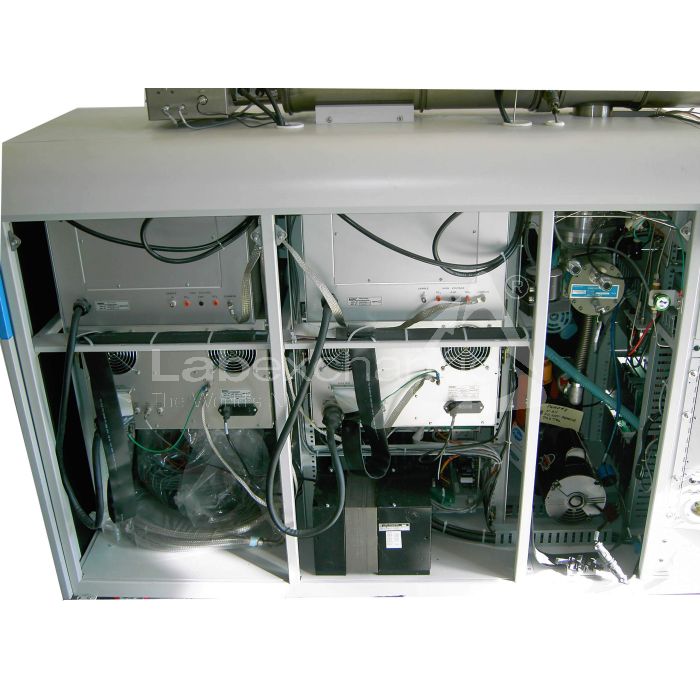Perkin Elmer API III
| Objektnummer | B00012132 |
|---|---|
| Numéro d'identification | 012132 |
| Nom de l'objet | Perkin Elmer API III |
| Statut | Stock unit |
Groupe de produits: LC / MS
Statut, conditions de livraison et de paiement
Vérification des appareils
Les appareils d’occasion sont vérifiés par Labexchange Service GmbH avant la livraison. Vous recevez des appareils entièrement fonctionnels.
Délai d'expédition
Les délais de livraison indiqués sont les plus rapides pour l’article en cause. Les délais de fait peuvent varier au cas par cas. Les délais de livraison définitifs sont indiqués dans la confirmation de commande.
Nous offrons des livraisons collectives par principe. Le délai de livraison s’oriente à l’article avec le délai de livraison le plus long. Une livraison partielle est possible par prix additionnel.
Méthodes d'expédition
Courrier, agences d'expédition, autocueillette, livraison par flotte de Labexchange
Conditions de livraison
Prix plus frais d’expédition. Les frais d’expédition indiqués sont à prévoir. Dérogations éventuelles sont possibles.
Si les coûts de transport ne sont pas spécifiés, s'il vous plaît demander séparément les frais de transport. Les frais de transport et d'emballage indiqués se réfèrent à l'itinéraire de transport le moins cher et sont sujets à des augmentations de coûts imprévues. En raison d'événements imprévisibles, les tarifs de transport et les délais de livraison peuvent changer à tout moment et doivent être adaptés à la situation actuelle. Incoterm codage selon les Incoterms 2010: Pour personnes qui viennent chercher les dispositifs elles-mêmes: EXW, pour les expéditions par voie maritime: CFR, par avion: CPT, d'autres expéditions: DAP. Remarque: Nous n'établissons pas des preuves préférentielles/EUR1. Dans le cas d’un enlèvement par vos soins/EXW de pays à l’intérieur ou à l’extérieur de la Union européenne, nous devons conserver 16% de TVA d’acheteur comme dépôt de garantie, jusqu’à ce que nous ayons reçu l’attestation de reception/la prevue de livraison.
Modalités de paiement
Nous n’acceptons pas le paiement par lettre de credit, PayPal, etc. Dans tous les cas le montant est payable sans déduction. Jusqu’au paiement complèt l’équipement reste notre propriété. Un escompte n’est pas accordé.
|
Pays |
Modalités de paiement possible |
Remarque |
|
DE, AT, CH |
Paiement par facture, prépaiement, par carte de credit |
Paiement par facture est possible pour clients professionnels. |
|
NL, BE, LU |
Paiement par facture, prépaiement, par carte de credit |
Paiement par facture est possible pour clients professionnels. |
|
Autre pays |
Prépaiement, par carte de credit |
|
Nos conditions de vente, de livraison et de paiement sont en vigueur. Vous pouvez télécharger les documents ici.
La vente intermédiaire nous est réservée.
Défintion des statuts
Tous articles sont d’occasion, sauf si explicitement défini comme « appareil neuf ».
|
Statut |
Condition |
Remarque |
|
Immédiatement disponible |
Occasion |
L’article a été déjà entièrement vérifié et peut être envoyé directement à vous. |
| En stock |
Occasion |
L'article est en notre stock, mais doit être vérifié avant la livraison par nos techniciens Vous recevez des articles entièrement fonctionnels. |
|
Publié |
Occasion |
L’article est toujours au l’offreur. Nous achetons, vérifions et en fin livrons l’article après votre commande. Le certificat de fonctionnement ainsi que le rapport de service sont inclus à la livraison. |
|
Appareil neuf |
Neuf |
C’est un dispositif neuf. L’article n’est pas utilisé et neuf d’usine. En ce qui concerne des article neufs, la garantie du fabricant est valable. |
|
Labprocure |
Occasion |
Responsable du contenu de l‘offre d’appareil est la société Labprocure GmbH, comme annonceur. Labprocure assume la responsabilité des offres annoncées ici ainsi que des photos et des textes d’offre inclus. Labprocure GmbH, Bruckstraße 58, 72393 Burladingen. |
Firma: Perkin Elmer
The API III system consists of the API III LC/MS/MS and an Apple Macintosh Computer with associated peripherals. A powerful and versatile system, the API III provides the capability of analyzing liquid streams for polar compounds. The term LC/MS/MS is used as a generic description of the separation and analysis processes which are provided by the system, including separation by Liquid Chromatography, CZE, IC and potentially ITP, and analysis by either MS or MS/MS.
In general, the amount of separation (chromatography) required is determined by the type of sample and the complexity of the matrix. In some cases, samples can be introduced directly with no separation, either by flow injection through an injection loop or by pumping the sample continuously through either an LC pump or the syringe drive provided with the system. In other cases, chromatography is required in order to separate the analyte from the matrix, thereby providing both added information (retention time) and reduced matrix effects. Similarly, some analyses may require the specificity of MS/MS for identification or confirmation, while others require only molecular weight information (provided by MS).
All of these combinations are available with the API III. It is up to the analyst to determine which mode of operation best satisfies the requirements of the analysis: chromatography or direct injection; MS or MS/MS; full scan, selected ion monitoring (SIM), or multiple reaction monitoring (MRM); or other MS/MS scan modes such as parent scan or constant neutral loss scan.
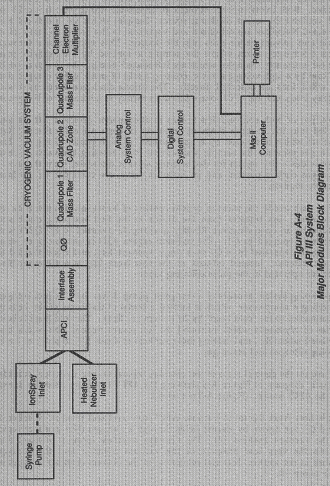
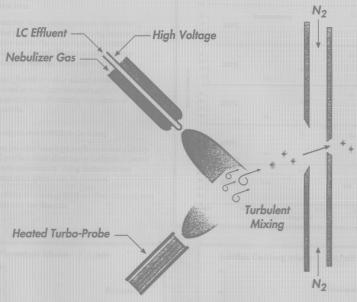

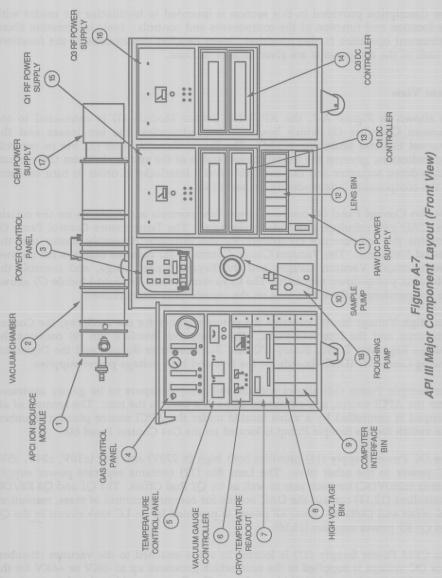
Positioning the Sample Inlets
Important: The ground plug for the IonSpray and Heated Nebulizer Inlets must be plugged in to activate an interlock which turns on the high voltage power supplies. When shutting down the system, remove the ground plug before closing the Ion Gate Valve.
The Ions created by both sample inlets are drawn into the mass analyzer by the electrical potential difference between the orifice and the tip of the IonSpray or, in the case of the Heated Nebulizer, the tip of the Corona Discharge Needle not between the orifice and the nebulized spray itself. Therefore, the spray should be directed away from the orifice for maximum sensitivity, to reduce chemical noise, and to prevent the orifice from possible plugging.
Consider the Interface Plate to be a clock face with the orifice representing the center of the clock:
IonSpray
The spray should be aimed at about 3 o'clock, 0.5" (1.2 cm) to the right of the orifice. The tip of the IonSpray should be about 1" (2.5 cm) back from the Ion Gate Valve (or set at the 2.5" mark on the z-axis scale). The IonSpray nebulizer tube should be at an angle of about 45 to 600 with respect to the Interface.
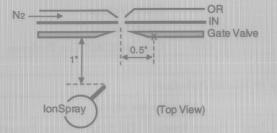
Heated Nebulizer
Turn the two positioning knobs on the Multi-purpose Front End counterclockwise to the end of their travel, then turn the adjusting knobs clockwise one turn. The spray should be aimed at about 1 o'clock, 1" (2.5 cm) to the right of the orifice. The tip of the probe should be about 1 to 3" (2 to 7.5 cm) back from the Ion Gate Valve.
The Corona Discharge Needle tip should be located slightly off-axis, about half-way between the tip of the probe and the Interface.
Operating the Heated Nebulizer
Turn on the Sample Pump and make sure that it is venting the plenum chamber. By adjusting the valve at the bottom of the plenum chamber, obtain a Source Delta P value of 0.8" H 2 O. With the Auxiliary and Nebulizer Gases flowing, increase the Heated Nebulizer's temperature to 400°C. After 5 minutes of warming, start the LC solvent flowing at 1 mL/min and increase the temperature to 480°C. This indicated temperature produces vapour temperatures of approximately 100°C. To prevent damage to the Heated Nebulizer, do not start the LC solvent flowing if the temperature is above 400°C.
|
Sample Inlet Voltage Settings |
|
|||
|
IonSpray |
Positive Ion Mode - ISP |
(Normal Range) |
Negative Ion Mode - ISN |
(Normal Range) |
|
ISV (volts) OR (volts) |
4800 60 |
(4000 to 5500) (35 to 150) |
-3800 -55 |
(-3000 to -4500) (-35 to -120) |
|
Heated Nebulizer |
Positive Ion Mode - HNP |
(Normal Range) |
Negative Ion Mode - HNN |
(Normal Range) |
|
Dl (microamps) OR (volts) |
3 60 |
(3 to 5) (35 to 120) |
-3 -55 |
(-3 to -5) (-35 to -120) |
|
Note: ISV and Dl are Iinked such that when either one of the parameters is selected, the other parameter automatically changes to a default value. |
||||
|
Sample Inlet Conditions |
|||||
|
lonSpray |
|
(Normal Range) |
Heated Nebulizer |
|
(Normal Range) |
|
Curtain Gas (N 2 ) |
0.6 L/min |
(0.6 to 1.8) |
Curtain Gas (N 2 ) |
0.6 L/min |
(0.6 to 1.8) |
|
Nebulizer Gas Flow |
40 psi |
|
Nebulizer Gas Flow (N 2 ) |
80 psi |
(40 to 100) |
|
Liquid Flow |
40 µL/min |
(1 to 200) |
Auxiliary Gas Flow(N 2 ) |
1 L/min |
(0.5 to 3) |
|
Interface Heater Liquid Flow for PPGs |
60°C 5 µL/min |
|
Temperature |
480°C |
(400 to 500) |
Note: The values given are intended as a general guide and may not be optimum for all systems.

Dl Discharge Needle Current
ISV IonSpray Voltage
IN Interface Plate Voltage
OR Orifice Plate Voltage
RO Q0 Rod Offset Voltage
M1 Q1 Park Mass
RE1 Q1 Resolution
DM1 Q1 Delta Mass
R1 Q1 Rod Offset Voltage
L7 Lens Element 7 Voltage
R2 Q2 Rod Offset Voltage
M3 Q3 Park Mass
RE3 Q3 Resolution
DM3 Q3 Delta Mass
R3 Q3 Rod Offset Voltage
L9 Lens Element 9 Voltage
FP Faraday Plate Voltage
MU Channel Electron Multiplier (CEM) Voltage
CC Count Control
CGT Collision (CAD) Gas Thickness
|
Ion Path Parameter Voltage Settings (IonSpray or Heated Nebulizer) |
||||
|
MS |
Positive Ion Mode |
Negative Ion Mode |
||
|
|
Q1 Scan (Norm. Range) |
Q3 Scan (Norm. Range) |
Q1 Scan (Norm. Range) |
Q3 Scan (Norm. Range) |
|
IN |
650 |
650 |
-650 |
-650 |
|
RO |
30 |
30 |
-30 |
-30 |
|
R1 |
27 (26 to 28) |
27 (26 to 28) |
-27 (-26 to -28) |
-27 (-26 to -28) |
|
R2, L7 |
-50 (0 to -150) |
-50 (0 to -150) |
20 (0 to 150) |
20 (0 to 150) |
|
R3 |
-50 (0 to -100) |
27 (26 to 28) |
50 (0 to 100) |
-27 (-26 to -28) |
|
L9, FP |
-250 (0 to -250) |
-250 (0 to -250) |
250 (0 to 250) |
250 (0 to 250) |
|
MS/MS* |
Positive Ion Mode (Normal Range) |
Negative Ion Mode (Normal Range) |
||
|
OR |
60 (35 to 120) |
-60 (-35 to -120) |
||
|
R2 = R3** |
-30 (-100 to 30) |
30 (-30 to 100) |
||
|
CC |
1 (1 or 10) |
1 (1 or 10) |
||
|
CGT |
400 (200 to 600) |
400 (200 to 600) |
||
|
* Ion Energy = RO - R2. The MS/MS state File should include the PPG state File values for RE1, DM1, RE3 and DM3. Additional sensitivity can be obtained by Iowering the resolution, i.e. by decreasing RE1 (or RE3) and/or increasing DM1 (or DM3). Note that the RE and DM values should be the same value and polarity whether in positive or negative ion mode. ** Use R2 = R3 for high sensitivity or for MS/MS of multiply charged ions. Use R3 Auto Scan Function for high resolution of singly charged parent ions where R3 = R2 + (R1-R2)(M3/Ml) . |
||||
Scan Conditions |
||||
|
|
Ml or Profile |
MRM or Ml with zero width |
Q1 or Q3 Scan |
Daughter, Parent or Neutral Loss Scan |
|
Step (amu) |
0.1 (0.05 to 0.25) |
not used |
0.1 (0.1 to 1.0) |
1.0 (0.1 to 1.0) |
|
Dwell (msec) |
10 |
100 |
1 |
5 |
|
Mass Defect (millimass units per 100 amu) |
not used |
not used |
not used |
compound dependent, e.g. 55 for peptides, use when Step > 0.2 |
Note: The values given are intended as a general guide and may not be optimum for all systems. If a parameter value is not given, it is assumed to be the PPG state file value.

